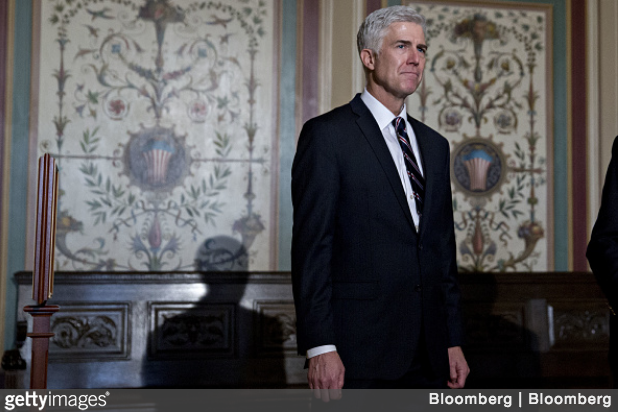So here comes the judge. After a promo build-up that some compared to The Apprentice, President Donald Trump ended the suspense that he’d purposely created by nominating arch conservative Judge Neil Gorsuch in a live Tuesday night broadcast from the White House to fill the seat left vacant since last February when Justice Antonin Scalia died at a Texas ranch resort. Gorsuch, a 49-year-old Coloradan, who was skiing in the Rockies when he heard the news, was so distraught over his mentor’s death that he cried all the way down the slope.
Now the tears are falling down Lady Justice’s face.
Ten years ago, President George W. Bush had nominated Gorsuch to the 10th Circuit Court in Denver, and the Harvard Law grad was confirmed by a voice vote. Eric Citron, a Supreme Court blogger, regards Gorsuch as possibly even more conservative than Scalia. On the campaign trail, Trump had said he would nominate jurists who opposed abortion and supported gun rights. Regarding LGBTQ rights, Gorsuch has been described as a “religious liberty enthusiast,” which means he supports the right of private companies to discriminate against gays.
Until the announcement, Trump had kept speculation alive by saying he was going to choose between Gorsuch and Judge Thomas Hardiman, 51, a Massachusetts native whom Bush had nominated to U.S. District Court for western Pennsylvania in 2003. Four years later, Hardiman was unanimously approved by the Senate to the U.S. Court of Appeals for the 3rd Circuit, where he still serves with Trump’s sister, Judge Maryanne Trump Barry. Fluent in Spanish and married to a Democrat, Hardiman reportedly had “more in common with Justice Sonia Sotomayor” than Scalia, according to one SCOTUS blogger. That probably was the deal breaker for Steve Bannon, Trump’s white supremacist advisor.
In a just world, this seat would have been filled last spring. President Obama nominated Judge Merrick Garland, the chief judge of the Court of Appeals for the D.C. Circuit, who was universally respected. Until he wasn’t. U.S. Sen. Orrin Hatch (R-Utah) had said back in 2010 that Garland would be a “consensus nominee” and there’d be “no question” that he would be confirmed for a seat that ultimately went to Judge Elena Kagan. Last year Hatch reportedly called Garland “a fine man.”
But Garland never even got the courtesy of a committee hearing. Senate Majority Leader Mitch McConnell (R-Ky.) put politics above the Constitution. The reactionary Republican kept the seat open so the next president could get his way. The blockage infuriated Democrats on Capitol Hill, and for good reason.
And what, you may ask, would have been the Republicans’ response had the polls been right and Hillary Clinton had actually won the election? Here’s what Sen. John McCain (R-Ariz.) had to say last October, with weeks left to go:
“I promise you that we will be united against any Supreme Court nominee that Hillary Clinton, if she were president, would put up,” McCain said. “I promise you.”
Will Senate Democrats follow the Arizona Republican’s example of all-out resistance now that Trump is in power? Senate Republicans need 60 votes to confirm Gorsuch. They start with 52.
So far, only U.S. Sen. Jeff Markley (D-Oregon) has staked out the firmest position, reminding Americans that the Supreme Court seat was “stolen” and promising to lead a filibuster of any Trump nominee.
“This is the first time in American history that one party has blockaded a nominee for almost a year in order to deliver a seat to a President of their own party,” said Merkley in a statement. “If this tactic is rewarded rather than resisted, it will set a dangerous new precedent in American governance. This strategy of packing the court, if successful, could threaten fundamental rights in America, including workers’ right to organize, women’s reproductive rights, and the rights of ordinary citizens to have their voices heard in elections rather than being drowned out by the corrupting influence of dark money from the richest Americans.”
Dark money is the real deal behind the consolidation of power in all three branches of government: the White House, Congress, and now the Court, once Chief Justice John Roberts gets his 5-4 majority back in Republican control. As The New Yorker magazine’s legal expert, Jeffrey Toobin, wrote in 2010, “Under Roberts, the Court has continued to use the equal-protection clause as a vehicle to protect white people.”
But let us not forget another horrible legacy of the Roberts Court: its decision on Dec. 6, 2010 in Citizens United v. Federal Election Commission that gutted the McCain-Feingold campaign-finance law by removing limits on corporate expenditures in political campaigns. Our democracy has never been the same since.
And while we’re drifting down memory lane, let’s recall how the conservative-dominated Supreme Court had awarded the Republicans the White House on Dec. 12, 2000.
In Florida, Texas Gov. George W. Bush had clung to a 537-vote margin over Vice President Al Gore—an eyelash considering that almost 6 million ballots had been cast in the Sunshine State. Split 5-4, the Court decided that Florida’s lower court ruling ordering a manual recount of all those hanging chads was unconstitutional. It struck observers at the time as rather hypocritical for conservative jurists like Antonin Scalia, who’d made so much about “judicial restraint” and respecting states’ rights, to interfere with Florida’s right to count its ballots the way it wanted. Asked about it in subsequent public appearances, Scalia told critics: “Get over it!”
So here’s the unhappy recap for those of us who still haven’t “gotten over it.” First it was the Court giving Bush 43 the win. Next it was the Court giving billionaire right-wingers like the Koch brothers a green light to spend as much dark money as they could muster. And now the Orwellian-named Judicial Crisis Network has pledged to spend at least $10 million to push Trump’s nominee through by focusing on states where Trump won, such as Missouri, Indiana and North Dakota. That’s just the tip of the iceberg.
As the Founders envisioned the Supreme Court, it is supposed to exert a check on the power of the executive branch. It seemed like an academic exercise when the notion came up in the last presidential debate in October. Trump said he would “instruct the attorney general to get a special prosecutor to look” into Hillary Clinton if he won. Clinton responded, “It’s awfully good someone with the temperament of Donald Trump is not in charge of the law in our country.” Prompting Trump to retort, “Because you’d be in jail.”
Given what we’ve seen the first two weeks of his administration, it’s not an idle threat. Previously, Trump had slammed federal district Judge Gonzalo Curiel because his parents were born in Mexico and therefore he couldn’t be fair in handling the million-dollar fraud lawsuit against bogus Trump University. The new president doesn’t take opposition lightly.
This week acting Attorney General Sally Yates, an Obama holdover, was summarily canned by Trump for refusing to carry out his anti-Muslim immigration ban. The president could fire her because the AG’s office is under the executive branch. But her replacement is expected to be right-wing, racist Alabama Sen. Jeff Sessions, who once joked that the KKK were “okay” until he learned that they smoked pot. Trump thinks the world of him.
Fighting to preserve the independence of the Supreme Court when our republic is threatened is truly a patriotic act. Hopefully, today’s elected Senate Democrats will channel their righteous indignation over the shoddy handling of Garland’s nomination and follow the example of the old liberal lion himself, the late U.S. Sen. Ted Kennedy (D-Mass.). He took to the Senate floor on July 1, 1987, to denounce President Ronald Reagan’s nomination of Robert Bork, who too many in the media had described as a mainstream conservative deserving confirmation. Kennedy wasn’t buying it.
As Kennedy put it: “Robert Bork’s America is a land in which women would be forced into back-alley abortions, blacks would sit at segregated lunch counters, rogue police could break down citizens’ doors in midnight raids, school children could not be taught about evolution, writers and artists could be censored at the whim of government.” Bork was accurately portrayed as an extremist and he was rejected 58-42.
Unfortunately, the picture Kennedy painted is alive and well in the America Trump’s supporters have created. If we can’t trust the president to uphold the Constitution, who can we trust?
Two thousand years ago, the Roman consul Marcus Tullius Cicero spoke out against the enemies of freedom when his republic was facing the threat of dictatorship.
“A nation can survive its fools, and even the ambitious. But it cannot survive treason from within,” he said. “An enemy at the gates is less formidable, for he is known and carries his banner openly. But the traitor moves amongst those within the gate freely, his sly whispers rustling through all the alleys, heard in the very halls of government itself.”
Now is the time for our Senate to be filled with 21st Century Ciceros.



























